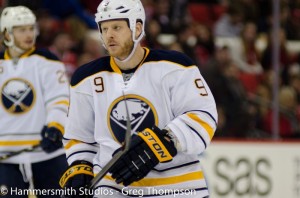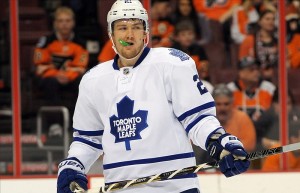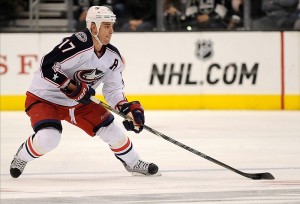This week, the National Hockey League will hit the midway point of the season. Because the year started in January (instead of October), it is often forgot who swapped sweaters in the summer of 2012. The offseason was full of notable trades, some of which were (and others were not) worth remembering. While many of these deals cannot be evaluated yet, it is worth looking at three notable trades of the 2012 offseason:
Buffalo and Dallas
Buffalo Receives: Steve Ott
This trade between Buffalo and Dallas, made in June of 2012, seemed to come out of nowhere. However, in hindsight the deal made perfect sense considering the mindset of the Buffalo Sabres. After being questioned by every hockey critic for a lack of toughness (most notably stemming from the Lucic-Miller incident), the Sabres began to search for an identity. That identity was represented in the form of Steve Ott, a tough forward who hits everybody in site and can be considered an intimidating presence with offensive skill. Through the first half of the season, Steve Ott has only shown both sides of his game. He’s scored 3 goals and recorded 8 points through 24 games, putting him on pace to match his average offensive production. He also has 43 penalty minutes, adding the grit and physical presence that the Sabres desired. He also has won 57% of all draws, the only bright spot in the faceoff dot for Buffalo this year. While he has performed exactly as people could have expected, the Buffalo Sabres have struggled this year. They’re sitting with a below-.500 record and have fired longtime coach Lindy Ruff. Unless the Sabres can find a way to improve the team, it will seem as if the toughness that Ott provides isn’t enough to lead them to success.
the mindset of the Buffalo Sabres. After being questioned by every hockey critic for a lack of toughness (most notably stemming from the Lucic-Miller incident), the Sabres began to search for an identity. That identity was represented in the form of Steve Ott, a tough forward who hits everybody in site and can be considered an intimidating presence with offensive skill. Through the first half of the season, Steve Ott has only shown both sides of his game. He’s scored 3 goals and recorded 8 points through 24 games, putting him on pace to match his average offensive production. He also has 43 penalty minutes, adding the grit and physical presence that the Sabres desired. He also has won 57% of all draws, the only bright spot in the faceoff dot for Buffalo this year. While he has performed exactly as people could have expected, the Buffalo Sabres have struggled this year. They’re sitting with a below-.500 record and have fired longtime coach Lindy Ruff. Unless the Sabres can find a way to improve the team, it will seem as if the toughness that Ott provides isn’t enough to lead them to success.
Dallas Receives: Derek Roy, Adam Pardy
While Adam Pardy cannot be called an impact player in any way, Derek Roy certainly is. Despite having surgery in the summer, Derek Roy has been incredibly consistent for the Dallas Stars. He has 14 points in 17 games, including leading roles on both the penalty kill and the power play. He’s stayed out of the box, been average in the faceoff circle, and is a “pass-first” player. He style of play in Dallas is nearly identical to that in Buffalo. His play this year seems to show that the Stars fetched a very nice return in this trade, but the outcome of this deal will depend on the summer. If Derek Roy, who is slated to become an unrestricted free agent, re-signs in Texas, the deal will look great for Dallas. However with Stephen Weiss having season-ending wrist surgery, Roy looks like the best option down the middle besides Ryan Getzlaf. If he lets money talk and tests the open market, it would sting as the Stars could have potentially gotten a longer-term investment for Ott. Regardless, Roy has been a good player this year which justifies the deal, at least for now.
Toronto and Philadelphia
Toronto Receives: James Van Riemsdyk

Very rarely does a deal that makes such perfect sense actually come to fruition. One team lacking offensive skill with a plethora of young defenseman, while the other had a surplus of offense and a defensive need, made a trade that was so simplistic and filled the required needs. Toronto received James Van Riemsdyk, the 2nd overall pick in 2007, in an attempt to fill the role of a big-framed forward that could score and crash the net. So far, Van Riemsdyk has done what has been expected of him and more. The winger has netted 12 goals in 23 games, surpassing his 2011-12 total. In addition, JVR has added a new dimension to the Maple Leafs’ game that has not been seen in years. His ability to park himself in the net and his ability to pounce on rebounds has made him a valuable commodity on the ice. In addition, his ability to cycle in the offensive zone and top speed have both been pleasant surprises for the Leafs. Toronto gave up a promising player in Luke Schenn, but must be happy that JVR has lived up to the expectations put upon him thus far.
Philadelphia Receives: Luke Schenn
In exchange for Van Riemsdyk, the Philadelphia Flyers received 2008 5th overall draft choice Luke Schenn. Between the Flyers’ need for defence following Chris Pronger’s concussion, and the fact that Luke’s brother Brayden plays for the Flyers, it seemed as if Luke heading to the city of brotherly love made perfect sense. Thus far, the older brother has quietly had a solid season for the Flyers. He is +6 on a negative goal-differential team, has 7 points on the season (including 2 goals), and averages just under 20 minutes a night. This includes over 2 minutes a game on the penalty kill. However, Schenn has not been perfect, needs to improve upon his foot speed and offensive awareness. However these facets of the game are always improving in eventual shutdown defensemen, something that Schenn aspires to (and likely will be) in Philadelphia, at least from what we have seen through 24 games.
New York Rangers and Columbus
New York Receives: Rick Nash
It took some time, but the Rick Nash show finally landed in Broadway. Thus far, the performance has lived up to the expectations. Nash, despite being slated alongside a struggling Brad Richards and Marian Gaborik, has been the best offensive player this year for the blueshirts. He leads the team in points (16), shots (72), and +/- (+8). In addition, he averages nearly a minute of short-handed time this season, and is second among all players in average power-play time per game. The only downfall for Nash at the moment is his goal production, only netting 5 goals in 16 contests. However, he is shooting under 7% which will certainly rise, and is a part of a stalled Rangers’ offence. When New York finds their offence, assuming it will, it appears as if Rick Nash will continue his respectable pace to his 2nd point-per-game season of his career.
Columbus Receives: Tim Erixon, Brandon Dubisnky, Artem Anisimov, 2013 1st
Following a long-winded and dramatic saga revolving around trading their franchise player, the Jackets were bashed for a lack of return for Rick Nash. In

actuality, all three players and the draft choice were all solid pieces in return for a player of Nash’s caliber. However the aura that Scott Howson created around Nash (which included demanding Jeff Skinner from Carolina or Sean Couturier from Philadelphia) resulted in the disappointment among the hockey community. Nearly six months later, where cooler heads have prevailed and rationalist views have arrived, and the deal does not look half-bad for the Blue Jackets. Two of the four pieces that Columbus received cannot yet be determined, as the first round pick has obviously not been selected and Tim Erixon is too young to have his three point campaign taken as a precedent. However, the two pieces which can be evaluated have both played distinct roles for the Blue Jackets thus far. Artem Anisimov has brought a lethal shot to the team with offensive talent, while Brandon Dubinsky has been a reliable center who has shown his toughness that was evident in New York. Both have battled with injuries and are playing for the team with the worst record in hockey, so therefore their states are not as appealing as they should be. However, with a few more surrounding pieces a couple years down the road, all four components of the trade that went to Columbus should be respectable, based off of what we have seen this year.